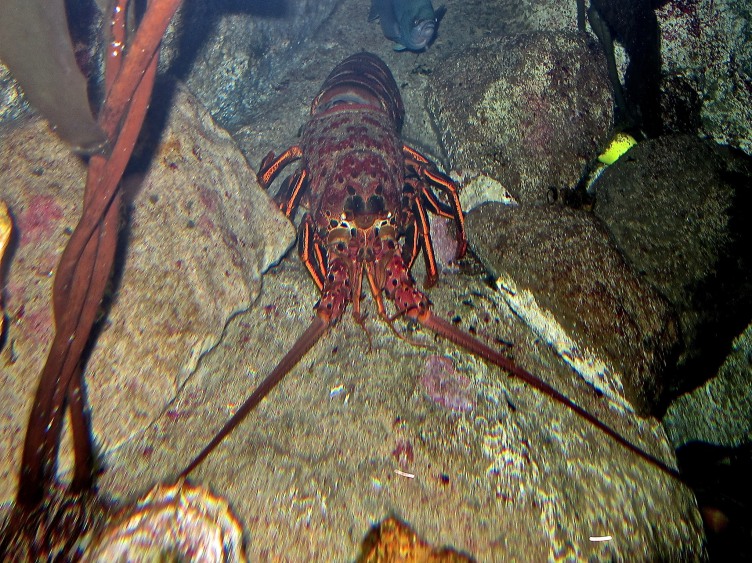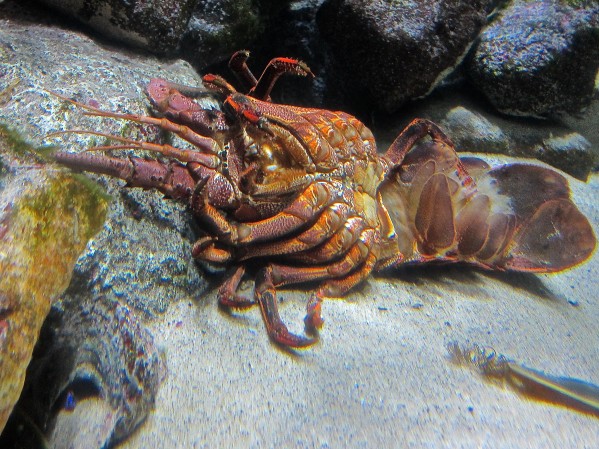TAXONOMY
Kingdom: Animalia
Phylum: Arthropoda (Invertebrate animal having an exoskeleton (external skeleton), a segmented body, and jointed appendages). Includes the insects, arachnids, myriapods, and crustaceans.
Subphylum: Crustacea ( crabs, lobsters, crayfish, shrimp, krill and barnacles.)
Class: Malacostraca (Body plan comprises 20 body segments (rarely 21), and divided into a head, thorax, and abdomen). Crabs, lobsters, crayfish, shrimp, krill, woodlice, scuds (Amphipoda)mantis shrimp.
Order: Decapoda (“ten-footed”) crayfish, crabs, lobsters, prawns and shrimp
Family: Palinuridae (langouste or rock lobsters)
Genus/species: Panulirus interruptus
GENERAL CHARACTERISTICS: One of the largest spiny lobster species. The exoskeleton is generally red to orange in color with black markings. Spiny projections are located on the carapace (upper shell) and sides of the abdomen. Their two primary antennae may equal the length of their body. Panulirus interruptus lacks the large pinching claws of their Maine lobster relatives. Average mass is 908 g (32.00 oz) ranging from 454 to 2270 g (16.00 to 80.00 oz). On average, they are 30 cm (11.81 in) long, though they can measure as large as 90 cm (35.43 in) in length.
DISTRIBUTION/HABITAT: Monterey Bay, California to Baja California, Mexico. Found in rocky reefs in caves and rocky crevices. Maximum depth 240 feet.
DIET IN THE WILD: Nocturnal scavenging on sea urchins, small clams, mussels, algae and worms.
REPRODUCTION: Breed once a year during warmer months. Males attach sperm packets to females where she can produce up to 800,000 eggs which hatch into tiny young after 10 weeks. They reach legal size for harvest at 7-11 years of age.
LIFESPAN: In captivity 8 to 25 years.
PREDATORS: Giant Sea Bass, California Sheephead, cabezon, horn sharks, Leopard Sharks, octopus, sea otters and humans.
The photo below is a recent Moult ( shedding of the exoskeleton typically to let the organism grow).
CONSERVATION: IUCN Red List and CITES No special status. California fish and game regulates taking of lobster which requires a sport fishing license. In 2003 over 270 metric tons were harvested.
REMARKS: For defense P. interruptus has sharp spines on the body, tail and antennae. It also can use its powerful flexing tail to flee predators.
Southern California Coastal Marine
References
Animal Diversity Web ADW, animaldiversity.ummz.umich.edu/accounts/Panulirus_interru…
California department of fish and game nrm.dfg.ca.gov/FileHandler.ashx?DocumentID=36321&inli…
Ron’s flickr https://www.flickr.com/photos/cas_docents/15790212682/in/set-72157608602469734/
WordPress shortlink http://wp.me/p1DZ4b-1pi


